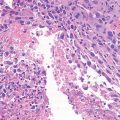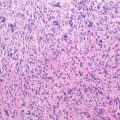Location: Usually at the end of long bones (femur, tibia, humerus), involving the epiphysis, both the epiphysis and the metaphysis, or, less frequently, an apophysis. Exceptionally, it can be purely metaphyseal. Less common locations are tarsal bones and pelvis, quite rare elsewhere.
Clinical: Moderate to severe pain nearly always present, relatively common also joint effusion, muscular hypotrophy and stiffness.
Imaging: Round or oval radiolucent lesion, small to moderate in size (1–7 cm) within the epiphysis or an apophysis or even extending across the plate; sharp margins because of a sclerotic rim. The cortex may be expanded but preserved in most cases. Usually no periosteal reaction. Calcification inside the defect in 30–40 %. A soft tissue recurrence tends to be well circumscribed by a shell of ossification. Isotope scan: coinciding with radiographic limits and merging into uptake of the physeal plate. CT: fine punctate calcification; presence of cystic areas. MRI: homogenous intratumoral signal, transphyseal extent.
Histopathology: Gross: pink gray to tan brown, overall “wet sawdust” aspect; areas of chondroid matrix, calcification, and hemorrhage may be easily recognized. Histology: combination of mononuclear cells and giant cell. Mononuclear cells have oval nuclei, sometimes with a coffee bean appearance. Chondroid matrix present in most. Chicken-wire calcifications present in a third of cases (but pathognomonic). Mitotic figures common, never atypical mitoses. Secondary ABC-like areas in about 35 % of cases.
Course and Staging: Slow growth, normally stage 2 at presentation; stage 1 rare, stage 3 infrequent (recurrences, pelvic lesions).
Treatment: Curettage: stage 1, stage 2, and some stage 3 lesions. Avoid opening of the joint whenever possible to prevent articular contamination. En bloc resection: stage 3 lesions with massive bone destruction and/or tissue mass, large recurrences. Recurrence rate: about 10 % after curettage, minimal following en bloc resection.







